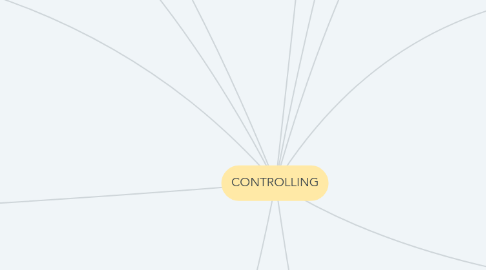
1. Control is a process whereby managers ensure that actual activities are conducted in line with the planned activities and take corrective actions to correct any mistakes that occur in order to achieve organizational goals.
2. The importance of controlling
2.1. Internal and external changes in an organization.
2.1.1. organization's size and decentralization
2.1.1.1. mistakes
2.1.1.1.1. allocation of power and responsibilities
3. The controlling process
3.1. Set the standards. (involves the formation of standards for each management activity such as sales and production target, attendance of employees, and safety records
3.1.1. Measure the actual performance. (managers must measure their employees performance is a repetitive process. To ensure that no mistakes occur while activities are being implemented)
3.1.1.1. Compare actual performance with the standards. (to identify whether the actual performance has met the standards. If not met the standards, mistakes might have occurred and corrective action must be taken)
3.1.1.1.1. Take corrective action. (managers can overcome this problem either by re-evaluating the standards or taking corrective action, for example repairing faulty machines or providing training for unskilled employees)
4. Principles of effective controlling
4.1. Flexibility
4.1.1. Accuracy of information
4.1.1.1. Timeliness
4.1.1.1.1. Focus on important factors
5. Financial control techniques
5.1. (1) Financial statements (used to calculate the financial value of an organization's internal and external products and services) (used to measure the following aspects: liquidity position; long-term liability and equity position; profitability position) (three main statement that is balance sheets; break-even analysis; funds flow statements)
5.2. (2) Audit (the process of analysing and identifying details that have mistakes, correcting the mistakes, and updating the financial statements after taking into account the mistakes) (usually audit will be conducted by external auditors who do not have any interest in the organization)
5.3. (3) Budget (quantitative statement stated in monetary value) (the types of budget: sales; production; direct material; direct labour; overhead; sales and administratives; pro-forma income statement; capital investment; cash; pro-forma balance sheet; operational; master and financial budget)
6. Modern non-financial control techniques
6.1. gantt chart
6.1.1. milestones budget
6.1.1.1. programme evaluation and review techniques/critical path analysis
7. Concept in control.
7.1. 1) output control/performance control (used to determine the actual performance or results exhibited by employees in an organization) (measured by efficiency,quality and feedback) 2) behaviour control (to ensure employee behaviour is in accordance with what is desired by the organization.
7.1.1. techniques that must be use to implement these controls: (a) budget to measure the organization's financial performance; (b) quality control to monitor employee behaviour; (c) self-evaluation by managers; (d) financial statements.
8. Characteristics of effective control
8.1. Accurate information
8.1.1. Comprehensive objectives
8.1.1.1. Timeliness
8.1.1.1.1. Easy to operate
9. Problems in forming rigid and flexible control systems
9.1. Rigid control systems. (a) employees will face pressure (b) low productivity (c) job performance will deteriorate
9.1.1. Flexible control systems. (a) low productivity (b) job performance will deteriorate (c) wastage of resources due to communication failure.
10. Types of controlling
10.1. (1) Feedback control. (performed before an activity starts) (usually involved in making policies, procedures, and rules to eliminate any undesired behaviour) (the objectives is to avoid mistakes that occur before the activity is implemented) (the advantages is the management can avoid any problems or mistakes from occuring) (the disadvantages of this type of control is ,not only it requires accurate information but also the right time)
10.1.1. (2) Concurrent control. (performed during the implementation of job or activity) (not only conducted on employees performance, but it is also conducted on human and non-human resources) (concurrent control can avoid bigger problems from occuring and more effective if managers obtain accurate information regarding environmental changes and the development of desired organizational goals at the right time)
10.1.1.1. (3) Filtering or yes/no control. (involves filtering process, whereby certain procedures must be approved before an operation is continued) (usually performed after the organization implements the activities and the results are obtained) (suitable for reviewing and evaluating the effectiveness of an activity)
10.1.1.1.1. (4) Feedback control. (to measure the results of an action) (any source of weaknesses in plans or standards can be identified) (sometimes called post-action or output control, feedback control focuses on the organization output) (used as the basis for giving rewards or motivating employees)
11. Traditional non-financial control techniques
11.1. statistical data
11.1.1. special reports and analysis
11.1.1.1. internal operational audit
11.1.1.1.1. self-evaluation by managers

